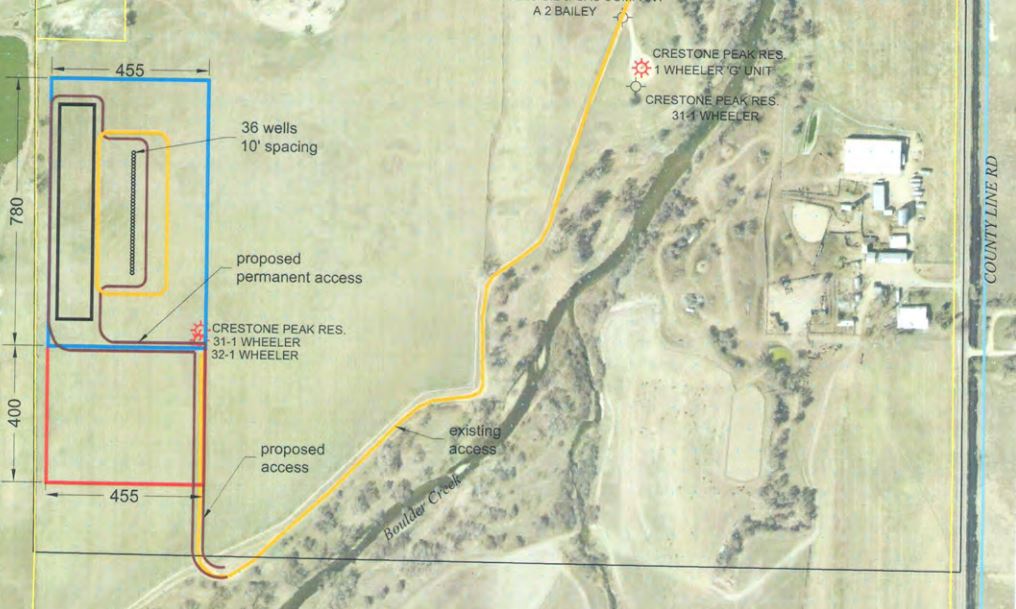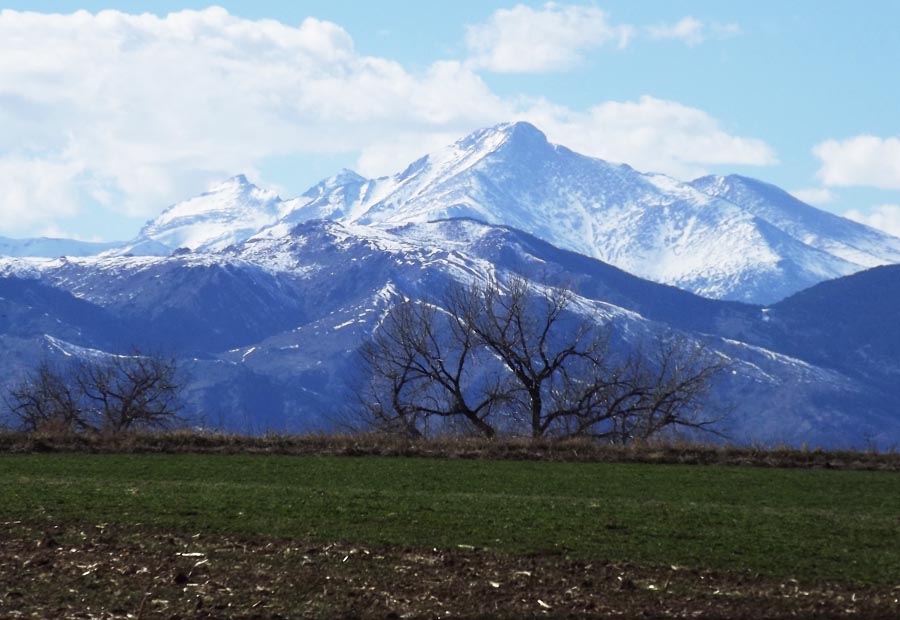Extraction’s 8 North LLC and Crestone Peak Resources have submitted drilling plans to the state to start developing Boulder County Wattenberg assets; commissioners “are very concerned”
In a county that is host to a symposium this weekend called “Warrior Principle, Climate Action,” it is not a total surprise that the Boulder County Commissioners sent out a county-wide email this week sounding the alarm that big oil was preparing to invade.
“Warning email” was sent to residents by the Board of County Commissioners
The email from the Boulder County Commissioners said, “On Monday, Sept. 11, Boulder County learned that 8 North LLC, a subsidiary of Extraction Oil and Gas, LLC, filed paperwork with the Colorado Oil and Gas Conservation Commission (“COGCC”) to begin the state permitting process for oil and gas development in two areas of Boulder County. The company has not directly communicated to Boulder County about their plans.
“If the State approves the drilling and spacing orders, 8 North would still have to apply to the COGCC for an Application for Permit to Drill that would include specific plans and proposed locations. In addition, the company will need to go through Boulder County’s local government regulatory process before any development could occur,” the Boulder County Commissioners said.

Crestone Peak Resources plans to drill 36 wells, 10′ spacing, on Boulder County on the Wheeler open space site.
Boulder County will oppose the applications
“Boulder County will oppose the drilling and spacing applications when they come up for a hearing before the COGCC, which has not yet been scheduled, and urges concerned residents to do the same.”
“The 8 North application was not the only recent development regarding oil and gas proposals in Boulder County. Last week, the Boulder County Parks and Open Space Department received letters from Crestone Peak Resources, LLC, requesting consultation on the use of four specific open space properties to locate well pads within the area of its proposed Comprehensive Drilling Plan (“CDP”).
“Boulder County has been closely monitoring the CDP since it was filed in February, but these letters are the first indication of actual wellsite proposals from Crestone. Crestone is proposing approximately 126 wells on the 1) Bailey-Kenosha Ponds; 2) ERTL, 3) Haley; and 4) Wheeler open space properties.”
Statement from the Board of County Commissioners

Boulder County Board of Commissioners (left to right): Deb Gardner, Elise Jones, Cindy Domenico. Source: Boulder County Board of Commissioners
We are gravely concerned by these two recent drilling and extraction proposals to develop oil and gas within unincorporated Boulder County.
We have reached out to the mayors, councils, and staff of Lafayette, Longmont, and Erie to alert them to 8 North’s unanticipated actions. We want to make sure that everyone who may be impacted by this development is aware, has the opportunity to express their concerns, and might participate in the state process.
As proposed, these operations would have significant and massive impacts on residents on the east sides of Lafayette and Longmont, around Erie, and in the unincorporated areas of east Boulder County. Additionally, impacts on county open space lands would be enormous, and would include intensive well development on the newly purchased Wheeler property along East County Line Road.
We will oppose the drilling and spacing applications when they come up for a hearing before the COGCC, and urge concerned residents to do the same. We are keeping our website up-to-date with all information we have related to oil and gas development in Boulder County.
Cindy Domenico, Deb Gardner, Elise Jones
Boulder County Commissioners
Based on their prior statements against oil and gas development, Boulder County’s commissioners have made it clear that they will work hard to oppose any company wanting to drill in Boulder County. Crestone Peak and 8 North want to drill and produce the same formations that filled the coffers in neighboring Weld County for decades, built new schools, fire houses and roads and made Weld one of the fiscally strongest counties in the nation and the only county in the U.S. with a 0% sales tax.
Boulder County Commissioners pledge to protect county from local oil and gas development
The county commissioners made a pledge “to continue to protect public health, safety and the environment from local oil and gas development,” and they are apparently sticking to their guns.
Boulder County and the cities of Boulder, Longmont, Lafayette and others want to control energy development within their borders, separately from the oil and gas regulating authority that is mandated by law and managed by the State of Colorado’s COGCC.
Previous statements regarding oil and gas development issued by Boulder County commissioners include:
“Colorado counties and cities have their hands tied by the state in prohibiting the highly industrial use of oil and gas development near residential areas. We are given too limited a regulatory role as compared to other similar uses, which is why it is so important for the county and our residents to continue to push the state for adequate local authority.
“We are all in this together, sharing the common goal of working towards what’s best for Boulder County. As your Board of County Commissioners, we pledge to continue to do all that we can to protect this county and its residents from the impacts of oil and gas development and to forge ahead with a cleaner energy future for us all.”
Last spring, Boulder County adopted the strongest set of oil and gas regulations in the State. Under the approved regulations, Boulder County will require Special Use Review for all new oil and gas development in unincorporated Boulder County.
“While we wish we could completely control or prevent all aspects of oil and gas development within Boulder County, we are doing everything we can under the current law to protect our local air, water, public health, and the environment with these new regulations,” Commissioner Elise Jones said in a statement.

Edge of the Wattenberg: Moratorium Expired in the spring, but will Drilling Return to Boulder County?
Boulder County’s new rules
Excerpts from the Boulder County oil and gas regulations that were adopted by Boulder County commissioners on April 11, 2017, including air quality and land use conditions, are reproduced below:
Review and Community Engagement
- Special Review Required. Except as provided for in 12-300, all oil and gas operations on public and private land within the unincorporated areas of Boulder County must comply with this Article. Prior to the commencement of any oil and gas operations in the unincorporated County, an Applicant must submit a special review application and the Board must approve the application according to this Article. No other form of discretionary land use review under this Code is required for oil and gas operations covered by this Article 12. Special review approval is also required prior to the issuance of any County building permits, or associated pipeline, grading, access, floodplain, transportation impact fee, or other County permits necessary for the oil and gas operation. Oil and gas operations that may not require a building or other associated County permit must still obtain special review approval under this Article.
- Community Engagement. Boulder County requires Applicants to engage with local communities, residents, and other stakeholders prior to exploration or development activity. The purpose of this engagement is to provide sufficient opportunity for comment on plans; operations, and performance, to listen to concerns of the community, and to address all reasonable concerns as a result of a proposed operation.
- Surface Use Agreements. Oil and gas operators commonly enter into surface use agreements with landowners at or near the location of the development. The County recommends that surface agreements not be finalized until the Applicant has completed special review,at which time the impacts related to the proposed siting of the operation will be analyzed.
- APD approval. Application and Permit to Drill (“APD”) approval from the COGCC is not local approval, and compliance with all terms and conditions of special review approval is required in addition to the requirements of APD approval. The County strongly recommends that applicants apply to the County for special review prior to applying for APD so that the Applicant is aware of applicable County requirements and mitigation measures prior to filing its APD application.
Air Quality
Minimization of Hydrocarbon Emissions. To protect air quality, hydrocarbon emissions control measures may be required, including, but not limited to, one or more of the following:
- Electrification from the power grid or from renewable sources of all permanent operation equipment with engines or motors that can be electrified.
- Pipelines for water delivery to the site.
- Pipelines for transportation of oil and gas away from the site.
- Limitations on truck traffic to and from the site.
- Implementation of “tankless” production techniques.
- Environmentally sensitive and efficient production techniques,such as using naturalgas onsite rather than flaring.
- For well pads that are not electrically operated, use of quiet design mufflers (also referred to as hospital grade or dual dissipative) or equivalent.
- Use of acoustically insulated housing or covers to enclose the motor or engine.
- Manufacture test or other data demonstrating hydrocarbon destruction or control efficiency that complies with a design destruction efficiency of 98% or better.
- Bleed and vent restrictions on continuous bleed pneumatic devices, intermittent vent pneumatic devices, compressor engines, heater treaters, dehydrator reboilers,process heaters-pilot flames.
- Proof that any flare, auto ignition system, recorder, vapor recovery device or other equipment used to meet the hydrocarbon destruction or control efficiency requirement is installed, calibrated, operated, and maintained in accordance with the manufacturer’s recommendations, instructions, and operating manuals.
- Emissions controls of 90% or better for glycol dehydrators. m. Zero-emission desiccant dehydrators.
- Hydrocarbon control of 95% or better for crude oil, condensate, and produced water tanks with uncontrolled actual emissions of VOCs greater than five (5) TPY.
- Year-round application of odor requirements as set forth in 5 C.C.R. 1001-9, §XII (as amended).
- Electronic surveillance monitors to detect when pilot lights on control devices are extinguished.
- Drilling, completion and operation of wells using closed loop pitless systems for containment and/or recycling of all drilling, completion, flowback and produced fluids.
- Emission controls of hydrocarbon emissions of 95% or better for centrifugal compressors and reciprocating compressors.
- Dry seals on centrifugal compressors.
- Routing of emissions from rod-packing and other components on reciprocating compressors to vapor collection systems.
- Reduction or elimination of emissions of associated gas from hybrid gas-oil wells (i.e. gas that is co-produced from a well that primarily produces oil), Including prohibition of uncontrolled venting.
- Emission control of 90% or better during liquids unloading (i.e. maintenance activities to remove liquids from existing wells that are inhibiting production), including the installation of an automated plunger lift.
- Reduction or elimination of emissions from oil and gas pipeline maintenance activities such as pigging, including routing emissions to a vapor collection system.
- Proof of compliance with State-required dust control measures and imposition of an opacity requirement as tested using EPA Method 9.
- Odor reduction or elimination outside a specified distance from the well site.
- Use of an automated tank gauging system.
Land Disturbance and Compatibility
Conditions of approval that will reduce impacts to the site, natural resources, environmental resources, agricultural resources, floodways and floodplains, wetlands, and recreational activities, and will enhance compatibility with the surrounding area or scenic and rural character may be required, including, but not limited to, one or more of the following:
- A change of the proposed location of the well pad that allows for extraction of the resource and mitigates the land use impacts.
- A reduction of the number of wells on a single pad.
- If occupants of residential structures within one (1) mile of a well or production facility site are significantly adversely affected by drilling and completion activities, reasonable disruption payments to those occupants. The presumptive amount of disruption payments shall be calculated as provided for in appendix 1, with reference to the expected time period from initiation of well construction through well completion and giving consideration to existing surface use agreements with such occupants. The presumptive disruption payments may be subject to changes based on special circumstances, such as the presence of home or land-based occupations, accommodations for occupants with special needs, loss of business income, and other factors affecting residen.ts. Any required disruption payments must be made at least sixty (60) days before commencement of well construction.
Table A: Rent Equivalencies
| Distance From
well (ft) |
House/Unit Size | ||||||
| Efficiency | 1Bedroom | 2 Bedroom | 3 Bedroom | 4 Bedroom | 5 Bedroom | 6bedroom | |
| 1-1320 | $905 | $1,021 | $1,240 | $1,763 | $2,065 | $2,374.75 | $2,684.50 |
| 1321 to 2640 | $452.50 | $510.50 | $620.00 | $881.50 | $1,032.50 | $1,187.38 | $1,342.25 |
| 2671 to 5280 | $90.5 | $102.1 | $124.0 | $176,3 | $206.5 | $237.5 | $268.5 |
Rents shown are for 2017
Rent Equivalencies for units/houses within 1 to 1320 feet of the well are valued at the Fair Market Rent as set by HUD for the year of disruption.
Distance from well is as defined in COGCC regulation 604(a) concerning Setbacks
Table B: Moving Equivalencies
| Distance From well |
Rate |
| 1-1320 | $2,300 |
| 1320 to 2640 | $1,150.0 |
| 2641 to 5280 | $230.0 |
Moving equivalencies shown above are for 2017. Each year starting in 2018 these rates shall be adjusted by the Consumer Price Index as set by the United States Department of labor, Bureau of labor Statistics for Denver-Boulder,all items, all urban consumers,or its successor index.
- Pad dimensions. Adjustment of pad dimensions to the minimum size necessary to accommodate operational needs while minimizing surface disturbance.
- Structures and surface equipment.Adjustment of structures and surface equipment to the minimal size necessary to satisfy operational needs.
- Shared infrastructure.Use of shared existing infrastructure by oil and gas operations, minimizing the installation of new facilities and avoiding additional disturbance to lands in a manner that reduces the introduction of significant new land use impacts to the environment, landowners and natural resources.
- Landscaping and irrigation. Landscaping plans including drought tolerant species that are native and less desirable to wildlife and suitable for the climate and soil conditions of the area. An irrigation plan may be required where buffering is accomplished with vegetation.
- Buffering of visual impacts.landscaping, berming, or other types of screening materials along the perimeter of the site between the surface equipment and surrounding areas.
- Maximization of the amount of natural screening available for the facility. Natural screening includes; but is not limited to, the use of existing vegetation as a background, the construction of the operation near screening stands of vegetation, or placement in valleys allowing topographic screening. Construction ofthe operation in a manner that minimizes the removal of and damage to existing trees and vegetation. If the operation requires clearing trees or vegetation, feathering and thinning of the edges of the cleared vegetation and mowing or br sh-hogging of the vegetation while leaving root structure intact, instead of scraping the surface.
- Use of buried or low profile tanks and less intrusive equipment. Use of “quiet” drilling and completion equipment, such as the Quiet Fleet design provided by Liberty Oilfield Services.
- Remote monitoring and control.Use of Supervisory Control and Data Acquisition or other remote monitoring of wells, including remote telemetry units, onsite control valves, onsite data acquisition devices, and radio network/modems The ability to trigger an automatic shut-down of a facility for any reason at any time.
- Testing of soil samples to determine the extent of contamination from any spill or release, as well as to determine the adequacy of any remediation efforts.
- Spills and leaks.A leak detection plan to monitor for fluid leaks.
- A risk-based engineering study for proposed pipelines and modified construction, operation, or spacing standards that may exceed the minimum requirements in 12-700(5) for pipelines based on the outcome of the study.
References:
Crestone Peak Resources Notice to Surface Owner locations on Open Space
Notice to Surface Owner letters from Crestone Peak Resources
8 North LLC Drilling & Spacing Unit Order Application areas map
8 North LLC Drilling & Spacing Unit Order Applications to COGCC
Related:
County Commissioners sign letter to Governor Hickenlooper regarding the Martinez v. COGCC Appeal

